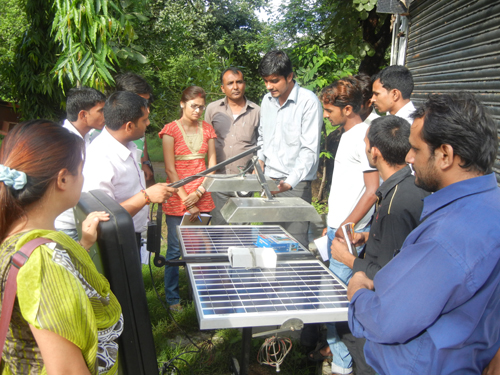|
Scaling Up TARA
Livelihood Academy into D riving through the villages and districts of Central India, you cannot help but notice the scores of young men hanging around, seemingly disinterested in the agrarian economy of this region. When you speak to them, they are quick to share their distress. Some are educated, many are school drop outs, some began working for daily wages in their teens. But all of them are seeking opportunities to improve their lives, earn some money and go beyond the confines of their villages.Hearing these discussions one would imagine that
there are no gainful opportunities. However as a paradox, it is easy to
see the surge of development in this region – roads being built, new
residential building complexes coming up in cities like Jhansi, lots of
shopping malls springing up across the urban land This paradox of growth vs. the seeming lack of opportunity with regards to livelihoods is the critical gap that TARA Livelihood Academy (TLA) has been designed to fill. Incubated by Technology and Action for Rural Advancement (TARA), which is a part of the Development Alternatives Group, TARA Livelihood Academy has been focused on creating a credible and sustainable business model to address this gap between youth and the available livelihood opportunities. While working with the core team at TLA over the last 6 to 8 months, two insights have become much sharper for me personally, which I believe could be the key levers for scale-up of TLA into a full-fledged business model. First is the need to focus on gainful and locally relevant livelihoods vs. employment and skill building. The reality is that we have close to 10 lakh youth joining the work force each month – ready to work, eager to create a life but have no opportunities in line of sight. Only 10% of this work force can be absorbed in the organised sector through skill building. Therefore, while there is a surge in urban development, it will take some time before large scale industry finds its way deep into rural India. Migration is not really a sustainable option. So TLA has the opportunity to become an engine for rural entrepreneurship development in the Bundelkhand region comprising of 7 districts in Uttar Pradesh and 6 districts in Madhya Pradesh. The advantage in training and creating entrepreneurs is that they would in turn employ many more people in their enterprises. This could be a highly leveraged model. Small-scale enterprises are required in agriculture, warehousing, farm equipment, livestock management, farm to market transportation, tourism, hospitality, education, apparel manufacture that will really benefit this region. Instead of waiting for people to come from outside to bring these services here, TLA can become the engine that can create these locally. The question that needs to be answered is - can TLA be the ecosystem enabler that can train entrepreneurs, scope new markets, link them to opportunities and to enterprise funding? Second is that TLA should integrate very closely with the government’s and industry’s agenda for rural livelihoods and skill development. It is crucial for TLA to leverage a profitable ‘centre of excellence’ model for its operations. This may require TLA to create a leveraged structure, a hybrid model that includes: • a non profit that leverages grant funds, government schemes and soft capital to train entrepreneurs and build skills in rural and urban youth. • a for-profit private limited company that connects trained youth with entrepreneurship opportunities and funding. This for-profit company would generate revenue from charging fees, revenue sharing and network management. I believe that TARA Livelihood Academy is really at the right point now to scale up and build a sustainable, innovative and relevant business model that creates livelihood opportunities for youth in Bundelkhand and other parts of India. q Parvathi Menon
|
 scape.
scape.